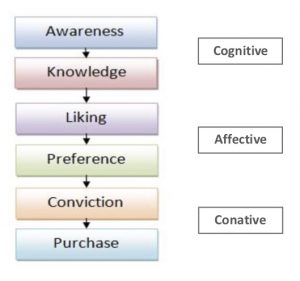An Important Skill Leaders Can Learn From Marketers
“Why do so many managers forget they’re human beings?”
That’s the title of a discerning leadership article published by Harvard Business Review (HBR). The authors of this article base their conclusions on insights gleaned from thousands of leaders around the world.
 A key supposition is that effective leadership – today – lies in a leader’s ability to form personal and meaningful bonds with the people whom they lead. This is particularly important to millennials who they suggest are not satisfied with only a paycheck, bonus, and benefits. They also want meaning, happiness, and connectedness.
A key supposition is that effective leadership – today – lies in a leader’s ability to form personal and meaningful bonds with the people whom they lead. This is particularly important to millennials who they suggest are not satisfied with only a paycheck, bonus, and benefits. They also want meaning, happiness, and connectedness.
So, what do they suggest is the best way to lead employees today?
Leaders must learn to be human beings before managers.
How to be a More Human Leader
To be a more human leader, here are 4 tips offered by the authors of this HBR article:
- Be personal – this is about putting yourself in the shoes of those you lead and imagining that they are family members or friends.
- Be self-aware – this is about understanding your own motivations and leading yourself first before attempting to lead others.
- Be selfless – this is about taking yourself out of the equation and considering the long-term benefits of others.
- Be compassionate – this is about being intentional in helping others and looking for ways to bring happiness to them.
Of course, these all make sense. And creating a more “human” form of leadership sounds rather appealing.
But I propose a simpler – and proven – model to help leaders better connect with others. It’s rooted in the study of Consumer Behavior and has been successfully used by marketers for years.
Learning from Marketers
It may be relevant to know that my personal field of study at university was Consumer Behavior. This is where I first took an interest in values, the connection between beliefs and behavior, and the publicly approved ways of expressing and justifying our defined needs (for more on this, see my eBook here).
When it comes to understanding psychology of human behavior, one university course in particular I remember was titled: Social Psychology.
Here the professor outlined the 3 areas we would be studying: Cognitive, Affective, and Conative. Not surprisingly, a number of students were a bit confused at these academic terms. (Though, I must admit they do appeal to those of us who love the meaning of words!)
In an effort to help these students, I suggested that they look at this course as a study of the marketing model I was also learning in Consumer Behavior:
- THINK (cognitive)
- FEEL (affective)
- DO (conative).
This simple change was like magic for these students. It was as if a light turned on and they suddenly “got it.” Since then, I find almost everyone can understand these simple terms: Think-Feel-Do.
 Specific to marketers, Think-Feel-Do is also known as a model of engagement that has been around for many years. For example, it is the basis of the Hierarchy of Effects model used by marketers to communicate and move prospective customers from awareness to action (which also sounds like something leaders could benefit from!).
Specific to marketers, Think-Feel-Do is also known as a model of engagement that has been around for many years. For example, it is the basis of the Hierarchy of Effects model used by marketers to communicate and move prospective customers from awareness to action (which also sounds like something leaders could benefit from!).
This model includes 6 steps in consumer behavior:
- Steps 1 & 2 (Awareness and Knowledge) addresses the cognitive (thinking) elements.
- Steps 3 & 4 (Liking and Preference) addresses the affective (feeling) elements.
- Steps 5 & 6 (Conviction and Purchase) addresses the conative (doing) elements.
In other words, for years marketers have honed their skills communicating with consumers and moving them from awareness to action using these 3 proven elements of Think-Feel-Do.
So why wouldn’t this also work for leaders?
Think-Feel-Do for Leaders
If leaders studied how marketers communicate with consumers (as humans), they would see that every communication has a specific purpose. Using the Think-Feel-Do model, imagine how leaders might re-evaluate their various communications by asking themselves the following questions:
THINK
- How do I first capture the attention of others, and encourage them to pay attention?
- Is this the best time and place to communicate my message?
- Why should they care to listen to me, right now?
- What are the most relevant and important details I want them to know?
- What’s the core message I want them to remember?
FEEL
- What do I want them to feel?
- What good will come to them by embracing what I want to share?
- What’s in it for them?
- What conflicts am I creating in them because of my message, and how can I alleviate that?
- Why should this become a priority in their life right now?
DO
- What level of commitment am I asking of others?
- What action do I want them to take?
- What’s the ultimate outcome I’m asking of them?
- What can they expect to receive or experience from taking action?
- Who ultimately benefits from this, and why?
Such questions can help a leader better connect with and move others along the pathway from awareness to action.
This applies across all forms of communications: from outlining a new plan at a team meeting, to a one-on-one coaching session; from setting expectations through a digital (or printed) newsletter, to conducting an employee’s performance review; from inspiring a group at a conference, to motivating an individual to change.
And no matter how much others might argue for leaders to be more “human”, there is much to be learned from marketers who understand human behavior.
Let’s also remember the purpose of leadership: to influence the thinking, emotional state, and behavior of others. Therefore, it’s a leader’s responsibility to know where others are along the pathway from awareness to action, and then choose the right communication format of Think-Feel–Do.









